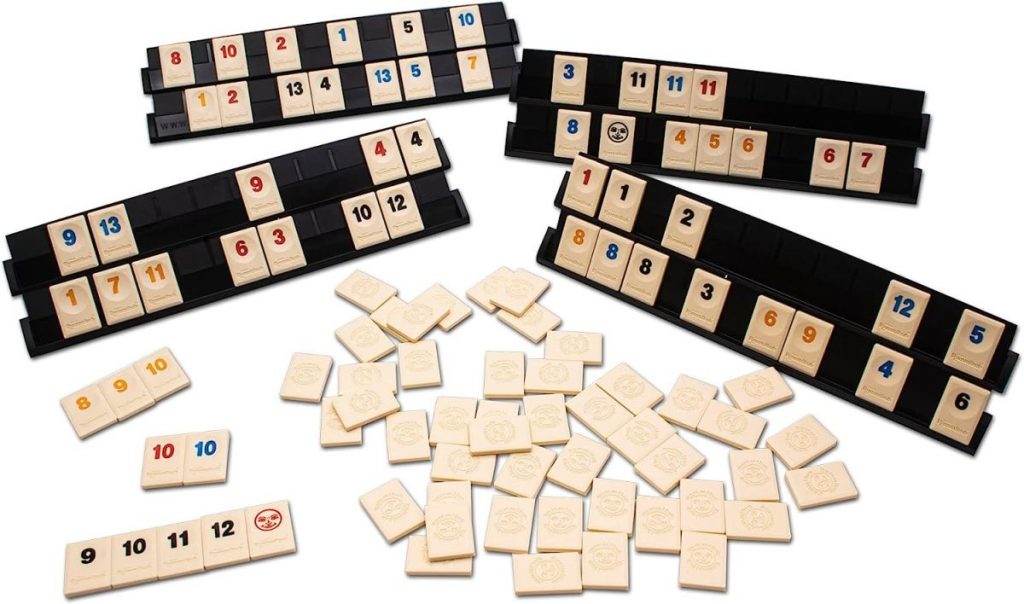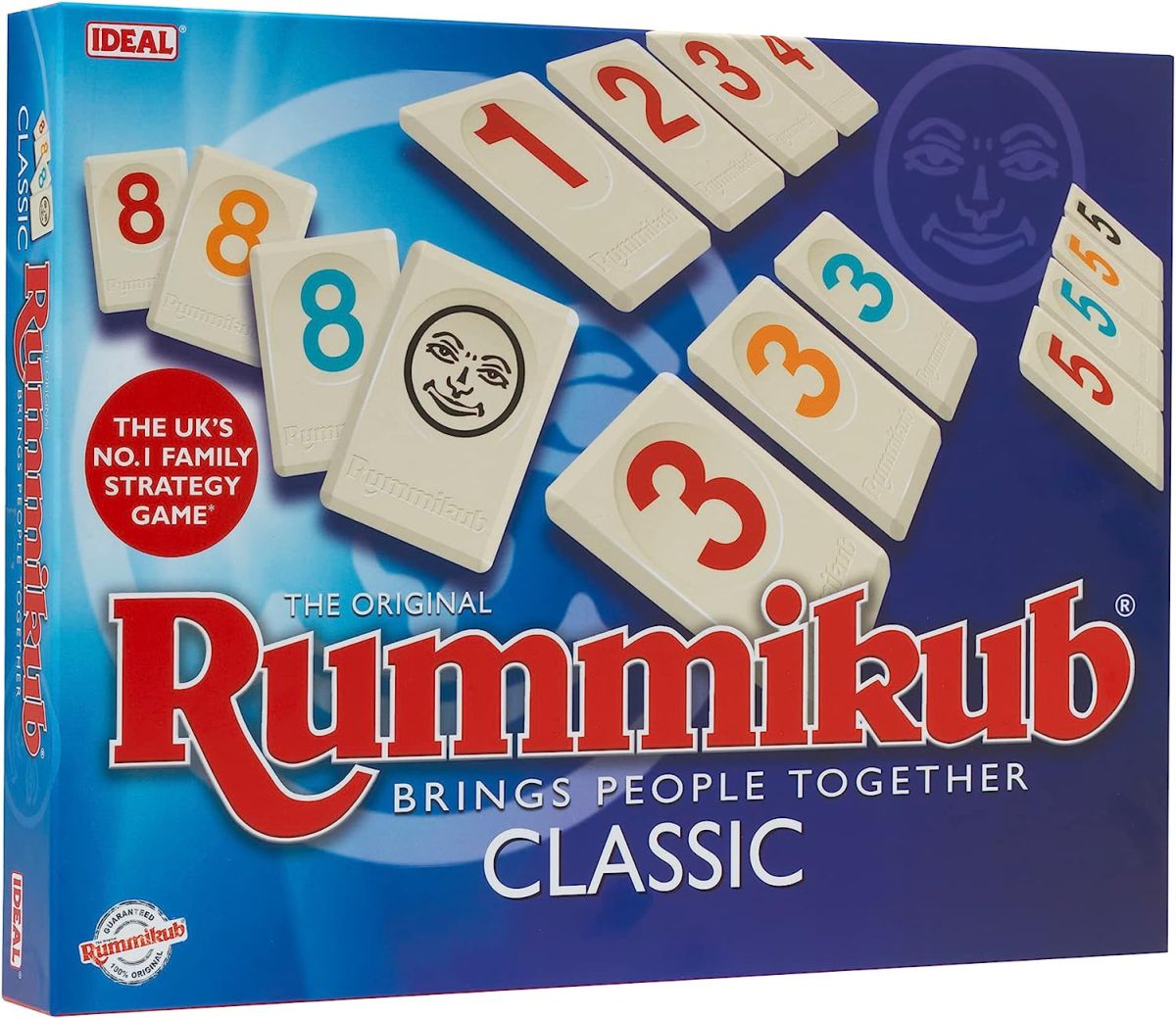When it comes to board games there is plenty of choice for your game night selection. Among the plethora of games available today there are classic board games that are still going strong. Games such as the number tiles game Rummikub. Rummibub (pronounced Rummy-cube) has been around since 1950 and is still played today and is much loved.
If you have ever played the card game Rummy or Gin Rummy, then you will love Rummikub – it is basically a tile-based version of the same game. It could be described as a combination of Rummy and the tile matching game Mahjong.
Rummikub was invented in the 1940s by Ephraim Hertzano, becoming much more popular in the 1970s and is still going strong today (you can read more about the history of Rummikub here). It now has several variations available including mini, travel, word and kid’s versions. It is suitable for 2-4 players, age 7+ and has a playing time of around 20-30 minutes.
In the box:
- 106 Tiles (104 Numbers; 8 sets 1-13 in 4 Colours; Black, Blue, Red and Yellow, 2 Jokers)
- 4 Racks and Rack Holders
- Instructions
In Rummikub, the aim of the game is to be the first player to get rid of all your tiles by building number groups or runs. It is an easy game to play but requires strategic thinking and careful play to win.
Before playing Rummikub, you will need a thorough read through the rules to completely understand them and how to play groups and runs. They are not hard instructions to follow but it might be worth playing a few test rounds to grasp the concept and learning the difference between groups, runs and sets, what a meld is and how to manipulate and split tiles that are already in play.
To play the game, each player is given 14 tiles. Player’s place these tiles on their racks (just as you would when playing Scrabble). The remaining tiles are placed face down on the table in-between the players. Each player then takes a tile from the pile and the person with the highest number starts. These tiles are then put back into the pile and mixed up again.

To get the game underway, players must lay down an initial meld. They must place a group or run on the table which has a value at least 30 points (you add up the numbers on the tiles).
- A group is a set of 3 or 4 tiles of the same number in different colours (but you can’t have 2 of the same colour).
- A run is a set of 3 or 4 consecutive number tiles in the same colour (e.g., 1, 2, 3, 4).
If a player is unsuccessful a new tile must be taken from the pile in the middle of the table and that players turn ends. The next player then must lay 30 points and so on until all players have had a turn.
After the initial meld has been played, going forward each player must play at least 1 tile from their rack. This can be by either adding a new group or run or manipulating one that has already laid (e.g., adding a red 4 to a sequence of red 1, 2, 3 already on the table). If a player is unable play a tile, they must draw one from the pile and add it to their rack with play then continuing with the next player.
The game continues with players laying down or manipulating runs and sets that have already been played to create others, until one player has laid all their tiles on the table and called ”Rummikub”. If you are playing more than one match, the losers add up the values of their remaining tiles and the total of all players is given to the winner as a positive score, whilst the loser(s) receive a minus score to the value of their own remaining tiles. After a few games, the player with the overall highest number of points is the winner.
Overall, I think Rummikub is a Marmite game – you will either love it or hate it. Personally, I love it. I think that it is a great game of strategic thinking combined with a small helping of Lady Luck.
I found that the instructions easy to read but will take a few read throughs to fully understand the gameplay, especially for the youngest players. But there are some excellent tutorial videos you can watch on YouTube and on the Rummikub website.
The game gets off to a slow start whilst runs and sets are being built up. After a few hands have been played and there are more tiles on the table, it does get faster and much more interesting. And the more people playing, the better it is.
With a maximum time of 1 minute per turn, it can get quite quick. This time limit is needed as waiting for another player to go through all the permutations in their head before taking their turn can be a bit tedious and could make the other players lose interest. Although if you are playing with younger players you might want to adapt this for their needs – we played with 1 minute for the adults and 2 minutes for the children.
I found it to be a fun, interesting and reasonably challenging game that gets you thinking and trying to outsmart your fellow players. I think that it is probably better suited for older children, teenagers and adults rather than 7 and 8 years olds, but it will definitely keep the family entertained.
As with a lot of tile-based games, I do have a personal niggle. The tiles are just placed back into the box loose, which annoys me. They bounce around everywhere when the box is moved (I fear losing some if the box is dropped). I feel that a storage bag for the tiles would be an ideal addition to the game so that the tiles could be stored better and stop tiles being lost.
I enjoy playing Rummikub Classic. It is a fun and challenging game for family and friends and would be great for an after dinner game night.
Rating: 4.5/5
RRP: £27.99
For more information, visit www.johnadams.co.uk. Available to buy from Amazon here.

